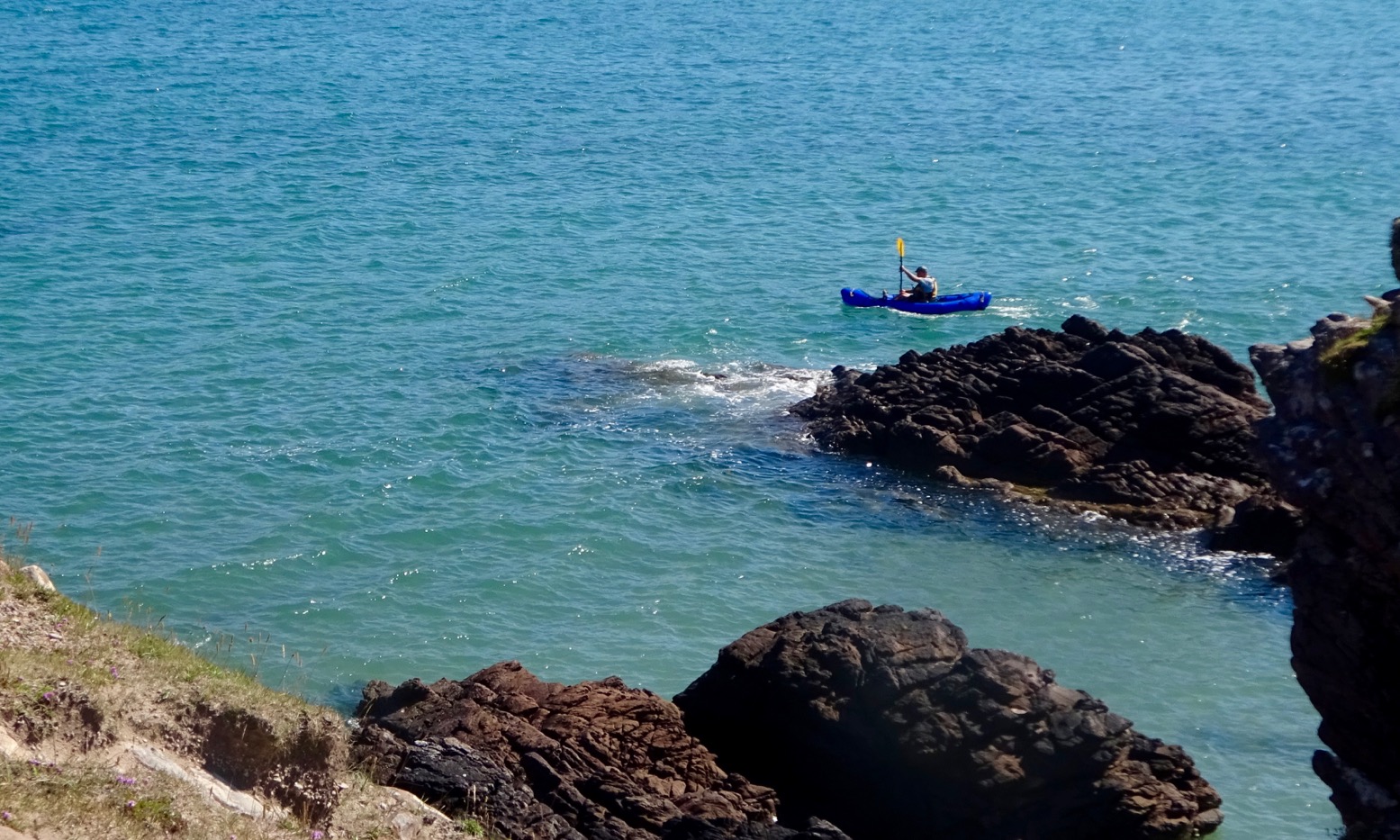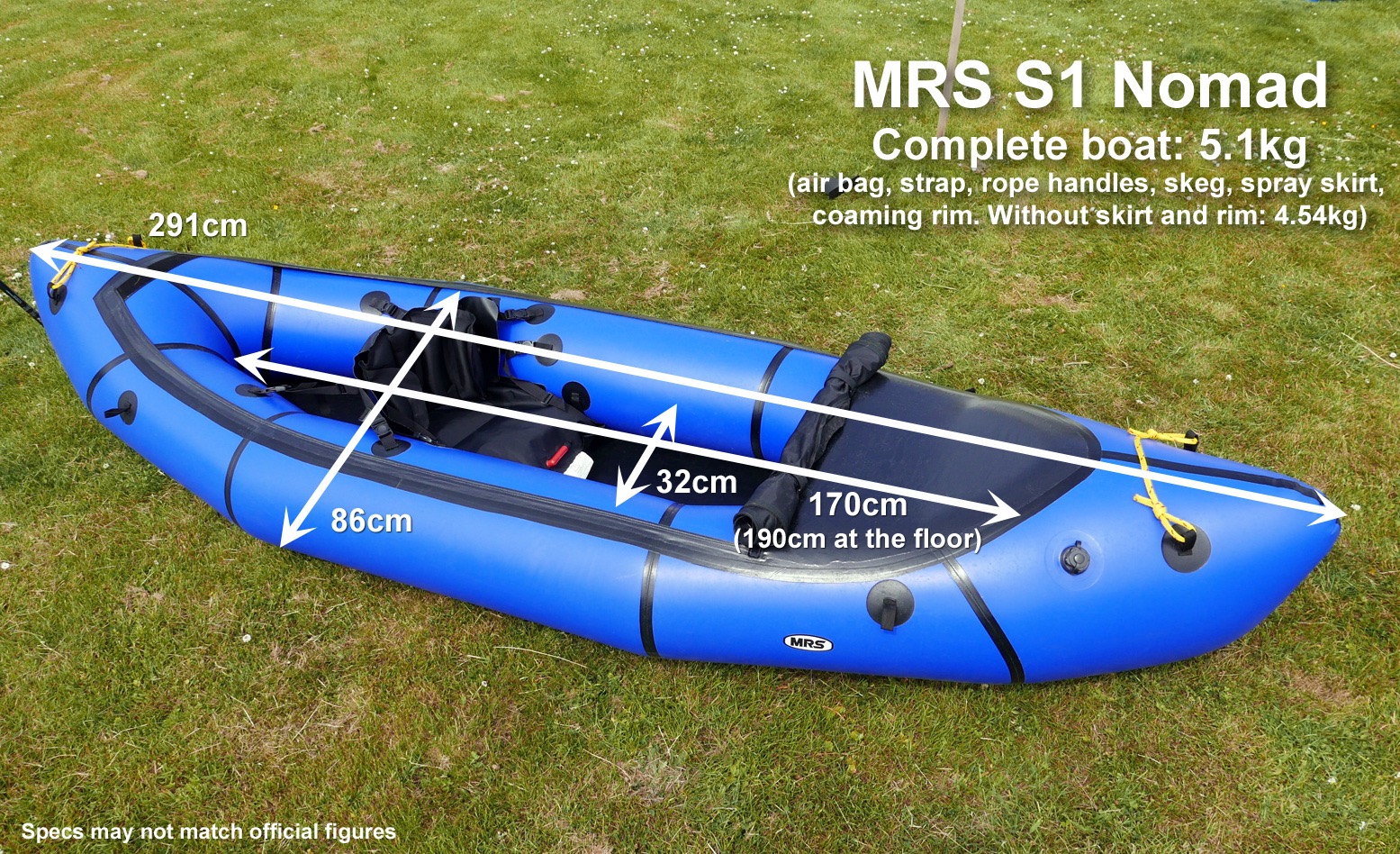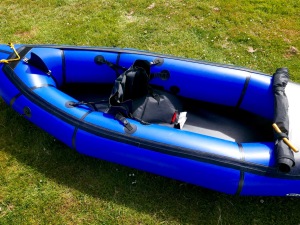
The application of what has proved to be durable, light and compact packraft fabric and reliable construction methods into slimmer, kayak-like forms was bound to happen. MRS’s 2.9-metre Nomad S1 is among the first solo examples I know of, co-designed with Germany’s Anfibio Packrafting Store whose Alpha XC we tested a couple of weeks ago.
Fyi: in December 2018 I sold my 2014 Alpacka Yak and bought this ex-demo boat.
Is it a very light solo kayak or a long packraft? I’d classify it as the former, a boat that ought to paddle better than a packraft on current-free, flat water, and even manage some calm coastal paddling. The Nomad could be mistaken as the solo version of MRS’s tandem undecked Barracuda R2 double. But the R2 is a boat with seats which can be adapted to canoe-style kneeling, much fatter tubes and has a different bow/stern as well as not having a deck. The 1299-euro Nomad S1 is a stand alone boat.

What they say:
Once packrafts broke conventions in water sports. Now the Nomad S1 is breaking conventions in packrafting. The central seating position and symmetrical bow and stern are similar to a conventional kayak, producing similar paddling dynamics. At 5kg, the gross weight is more than most solo packrafts, but the Nomad remains a very packable boat for easy travel and exciting adventures.
‘Sign here please’
Off the van, out of the box and straight onto the kitchen scales. Kerching: that will be 5.1kg please. Take away the large skirt and coaming rods and it’s down to 4.5kg, and a year later rigged up to my specs with a long lanyard, footrest, alternative non-inflatable seat back with a mesh pouch with bits in it, it is a real-world 4.7kg ready to go (right).
Hull fabric is your usual 210D TPU but coated inside and out (like old Alpackas) for improved rigidity, with a floor in chunky 410D with aramid (kevlar) fibre reinforcement. The hull panels are stitched, then heat welded with tape; the floor gets glued to the hull and all the joins look neat and crease free. The deck and seat parts are lighter PU-coated or ripstop nylon.
Unrolled, it looked like a lot of boat to have to blow up with the air bag. So I decided to speed things up with my IK barrel pump, using a bit of garden hose as an adaptor via the air bag screwed into Boston-style valve. More on those here. It took less than 5 minutes pumping. Later, I decided to try regular airbagging and found it only took 15 bagfulls to get it ready for topping off – less than you’d think.


To top off I found a shorter section of garden hose fitted neatly into the one-way valve port and makes it much easier to give the boat a few lungfulls and get the high-capacity boat nice and firm. A short bit of hose also fits into one adapter on my K-Pump which I usually use to top up my IK. With a K-Pump you can get it good and firm (but you can with much cheaper mini, balloon pumps too). The Packrafting Store offer a small Bravo foot pump for those who don’t have the lungs of Dizzy Gillespie. You do want to get this long boat as firm as possible, especially if you’re well-fed. But the Store recommends not to overdo it with a pump, and in the current warm spell I’ve been careful to air off a bit if the boat gets left in the sun all day following a max top off in cold water.
Once aired up the boat has a good shape – nice pointy ends; a promising sign in boating circles. The S1 is symmetrical like many IKs, and each end has a generous volume helping achieve a claimed buoyancy rating of 200kg. I can believe it; two of me in it and I bet it would still have plenty of freeboard.
The deck seems to be less flimsy ripstop fabric than I recall on my previous Alpackas. And unlike those boats which had a long perimetre zip, the Nomad has two parallel zips along each side right to the back which makes it dead easy to partly open and get to the ‘trunk’ without complete removal. Good design. You also wonder if the zipped-up deck might help tension the boat by constraining the sides when getting bent about in rough water. Maybe.

The 80cm x 49cm hatch is nice and big; I (1.85m) could get in and out with ease, though maybe not just after Christmas while wearing a drysuit and thick fleece. There are zips along the hatch rim to insert the 4-piece coaming rod (left) to make a firm seal for the spray skirt elastic. It struck me paddling later with the deck deployed that fitting the rods would create a 1–2-inch high lip which would keep out some water rolling down the front deck. The supplied spray skirt looked huge and had braces; but I never actually tried it. Rolled up to the front, the rolled up deck’s retaining velcro straps seem way too long. It didn’t really matter, they tucked in well enough. Maybe the extra strap length is to roll the unused spray skirt in there too.
The two-piece inflatable seat and backrest are not your ordinary packraft affair. The anatomically curved backrest hangs from no less than six adjustable pivoting mounts using q/d clips (right) to reduce stresses on the mounts and help fine-tune your back support. A TPU sheet sewn to the back rest back takes the buckle tension. This backrest won’t flop forward as on some packraft one-piece backrest/seats – very handy when clambering in, especially through the hatch. The whole backrest weighs 310g and costs €39 if you want to fit one to your boat. It detaches in seconds, handy to allow a passenger to temporarily hop in.
Solo, the mass of your weight settles on the thick, seat pad. It’s attached via the usual, very much not easily adjustable or removable lace-up tab mounts, except they’re glued on halfway up the hull sides at the 32-cm narrow point (left), not down on the floor’s edge as on regular packrafts. One problem with this laced set-up is if you want to move the seat much more than an inch or two forward or back. Depending on your weight there will be fewer holes taking the load. It can’t be beyond the wit of packboat design to allow easy removal or repositioning.

The S1’s clever seat arrangement partly supports the paddler’s weight from the big side tubes and so limits undesirable ‘bum sag‘. The Nomad does not sag like the underwater image above (an unknown packraft). In this boat the weight of the paddler presses directly on and deforms the floor which can’t be good for hydrodynamics or floor wear and tear in the shallows.
Paddler weight pressing down midway in a long, low-pressure boat – even with an inflatable floor – tends to make it bend in rough water or a swell. You can see they thought about this with the longer-than-normal Nomad. It was the problem that limited my old Gumotex Sunny (water came over the sides in rapids or a swell) which was eventually solved by getting the more rigid, higher pressure Seawave (and which is solved entirely by drop-stitch technology).
Flip the boat over and you can see that there are slight bulges at each end (left). I’m told it’s a cunning design feature to produce ‘negative rocker’ (opposite of upswept ends) and help with tracking and speed. The similar-sized EX280 we tried was flat floored and I must say it seemed to work. The S1 tracks fine without the skeg.
The 410D floor has a good overlap of glue where it attaches to the 210D hull tubes covering the tube seams (glued because I think you can’t easily heat weld two different deniers of TPU). The quality of the taping is all as neat as you like, with not a single strand of stray glue or malformed creasing.
The skeg (directional fin) is Gumotex size but slips on like a Sea Eagle IK (‘American box fitting’ iirc, same as on iSUP boards) into a moulded plastic slot glued up the stern. It locks in place with a flat pin on a string so when removed you can secure the skeg somewhere via this pin and string. I do the same when packing my Seawave so as not to misplace the sometimes vital skeg. Even when not mounted, that skeg pad is the lowest part of the boat which scrapes first so usefully sparing the floor from damage.
Other than that you have four well-positioned attachment loops, with a broad base to secure anything up to a bike. There’s the same arrangement on the stern. These mount points become less essential because you have space behind the seat to stash stuff low and retain stability and visibility. There are two more long loops inside, with another pair of mount points at the front for thigh straps. The test boat also had some handy string handles knotted on to the outermost attachment loops.
S1 at Sea
There are no rivers near here bigger than a boulder-filled burn right now, so we took the S1 out along a rocky coast, along a slightly surfy beach, then rinsed it off with a quick sail down a freshwater loch.
I don’t know if it’s the greater size, the kayak-like handling, the reduction of front-to-rear yawing or the elevated seat, but on a less than smooth sea I took to the S1 straight away. Despite being another single chamber packboat, it inspired confidence that I’d not necessarily experience in my smaller Alpacka Yak.
I paddled it without the skeg and as expected, can’t say I missed it. The Nomad tracked very well and, compared to my Seawave kayak, doesn’t really produce enough glide per stroke to send it drastically off course, notwithstanding the small corrections you subconsciously make as you paddle along. I wonder if the lightness of the boat as well as its flat floor are what makes these intuitive micro-adjustments in tracking so effective. Who knows, but if attempting longer, more exposed sea crossings (I’m talking a mile or more, not Nova Scotia) a skeg must be a good idea to stop the boat getting pushed about from the sides, especially with a tail wind.
Without the skeg I appreciated the S1’s agility nudging in and out of the rocks as a light swell rolled in. Stability was very much not an issue; being jammed in more or less at the narrow 32-cm width with feet touching the distant bow and the well-designed backrest all helped. My hips are 40-cm wide but I didn’t really notice the squeeze as I would were I down on the floor. Up to a point you can brace with your shins which are so close together there wouldn’t be much play to pull on thigh braces (actually not so – they work OK; right).
Over by the beach occasional foot-high waves were thundering on the shore; a chance to get knocked about a bit and have some fun. The stability made it easy to play around, with enough agility, clearance and central weight to spin quickly in the shallows before getting beached. Sure, some water came in, but on a warm day it’s a lot more fun playing with an open boat. To drain it just hop out, flip over, flip back and hop back in.
Even without the skeg, the central, kayak-like paddling position, as well as the length (Length-Weight Index 3.38 – about half that of a typical hardshell sea kayak), pretty much eliminates your typical packraft yawing. Not so sure about crossing over and circling the Summer Islands – it’s still a single-chamber craft – but I can see coast-hopping being enjoyable in the way it wouldn’t be in a regular solo packraft. On the way back from the beach against a quartering wind, the GPS recorded a brief high of 4.1mph paddling along normally.
We nipped over to freshwater Loch Ra which is now so low I had to wade a couple of hundred metres to find some depth. The skeg was now on but I can’t say I felt like it made much difference the way it would do on my IK. We went out on my Seawave a few weeks ago and the forgotten skeg was a right pain downwind. Upwind it’s barely necessary.
I hooked up the WindPaddle to the yellow string handle. The breeze was blowing only about a 6-8mph but the Nomad picked it up and ran with it up to 3.5mph – as fast as I could have paddled. Again, I don’t think the skeg helped with the tracking as the boat was effectively being dragged along by its nose like a wet towel.
Later in the afternoon I went back out onto the loch, paddling up briskly to the windward end where I let the sail take me back down. It wasn’t blowing enough to break any records but it’s nice to sit back and listen to the plink-plink of the water slapping under the bow. Mid-loch it felt like it was doing a good 4mph.
I’m really getting into this WindPaddle; I like the way you can steer up to 30° either side of the wind. On this boat it was easy to pull the sail down, cross it over once and tuck it under the knees, even with the deck on. There’s more Nomad WindPaddling here.
Back at the bank I removed the sail and the skeg and went for a scoot upwind, across-wind and downwind, but still can’t say the boat was hard to track. Maybe with more of a backwind it would get out of shape, but by then the waves would briefly lift the skeg out on the crests and possibly push it around. It’s nice to have the option but also good to know the Nomad handles well enough without a skeg on loch and coast.
Fyi: if you think your boat also needs a skeg (directional fin), the Store sells an inexpensive skeg and glue-on patch from 420D floor fabric. There’s a template here.
Nomading it Up
Good to know first impressions can be correct. I saw the promise in the Nomad S1 when I first clocked it on the Packrafting Store’s website. It is nearly the same length but more than half the weight and rolled-up volume of our old Gumotex Solar 300, but longer than the current 9-kilo Gumotex Twist 1 which, at just 2.6m has only half the buoyancy (ie: not much at all).
Trying it out on sea and surf-ish and loch, with sail and without skeg, I could seriously consider replacing my Yak with a Nomad (later, I did). I think there’s a potential for a skirt-free model and I’d even suggest the skeg could be an option too (P-Store make one of those too, now: S1 Light; right no skeg, deck, or braces and a 4-mount foam backrest).
The main drawback is the €1299 price – that’s about £1150 or the same as a top-of-the-range, made-in-Europe Gumotex with a deck or rudder option and a signed certificate from Brzeslaw Gumotek. Longshore sell the less sophisticated EX280 double in what looks like the same fabric for half that price, and the Store themselves have albeit basic packrafts from €470. They say the deck costs a lot to make and fit but fabric and assembly in China can’t be that disparate. Of course the price you pay is right for a boat which gives you years of fun, as I have found. An Austrian Grabner double IK can cost over €3000, so can an Incept.
Alternatives to S1
As for alternatives there is really nothing like the Nomad at the moment, partly it’s because the extended stern idea has greatly improved the dynamics of packrafts, positioning the paddler more centrally but adding length without interior space. Best choice would be Anfibio’s TXL which is now my main boat.

A Nomad or TXL may be on the weight limit of classic land-and-water packrafts, but they certainly make travelling somewhere by plane or a train or on a pushbike much less of an effort than with even the lightest IK, while giving IK-like performance once on the water, be it a gnarly river, a windy loch or a rocky seashore. Kayakraft? Packayak? It’s definitely not a kakraft.
Thanks to the Anfibio Packrafting Store for supplying another test boat. More about it here.
“The Nomad is another co-development between Anfibio Packrafting and MRS (Micro Rafting System). Combined with MRS’s manufacturing expertise and fabric know-how, our years of packrafting experience helped refine the design of the final product. Serial production takes place in the Far East with manufacturing carried out in small, hand-built batches. All products have an extended three-year warranty.”


























Is MRS rafts originated from China or Germany? I am quite confused as there is a site on aliexpress about the MRS brand…
[link removed]
LikeLike
MRS is a Chinese brand. Packrafting Store in DE has worked with MRS in boat design and spec and was the first to sell them in Europe. China-direct MRS boats may be different but from the [removed] link they look the same, including prices.
LikeLike
Thanks, Chris. I was concerned with getting from the wrong source.
LikeLike